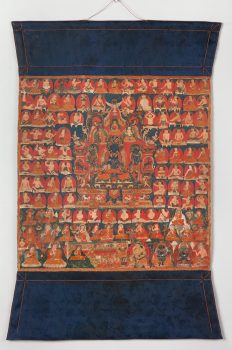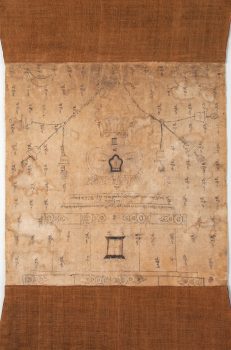Western Tibet
15th century
This gesture is that of embracing a consort and is symbolic of bringing together two aspects of enlightenment: wisdom and method.
Western Tibet
15th century


An elaborately crowned Vajradhara, primordial guru of Tantric lineages, sits in the center of the composition surrounded by the eighty-five great tantric adepts (mahasiddha), the exemplary practitioners of those teachings. Each of these adepts is engaged in a different activity and is identified by an inscription, following the verse eulogy attributed to the Indian master Vajrasana (about 1100). An interesting feature of this painting is the large number of adepts shown in strenuous yogic poses. Vajradhara is seated on an elaborate throne with wide pillars and adorned with multicolored scrolling sea monster (makara) tails. Such features identify it as art of the ancient kingdom of Guge in western Tibet.The back of the painting features a stupa with a number of atypical features. Windows are found on both the base and the square section on top of the dome (harmika). The dome also has some odd details, including a niche and decorative eyes. The chains with bells and the representations of the crescent moon and the sun, although common symbols that stand for eternity, are particularly remarkable here for their large size and unusual depiction.
A religious movement that originated in India around the fifth to seventh century with sacred writings and esoteric teachings and practices transmitted from teacher to student through initiation. These remain an important part of Hinduism and Buddhism today.
The passing down of authentic Buddhist teachings from a teacher to a disciple or student, often in the form of a text in a ritualistic context.
The transmission of teachings from one generation to the next, from teacher to student, traced all the way back to the Buddha without interruption. A complete lineage is essential in Tantric Buddhist practices as it makes the blessings of the teaching more powerful.
An awakened being who understands the true nature of reality and is free from the cycle of birth, death, and rebirth. While there are many buddhas, Siddhartha Gautama is the historical Buddha, whose teachings became the foundation of Buddhism.
Today, Tibetans primarily inhabit the Tibetan Plateau, situated between the Himalayan mountain range and the Indian subcontinent to the west, Chinese cultural regions to the east, and Mongolian cultural regions to the northeast. During the 7th to 9th century, Tibetan rulers expanded their empire across Central Asia, and established Buddhism as the state religion.
Get the latest news and stories from the Rubin, plus occasional information on how to support our work.